

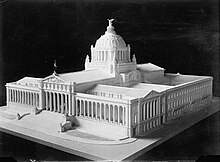
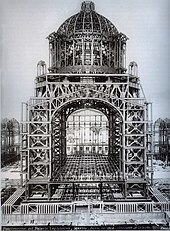
The Palacio Legislativo Federal (Federal Legislative Palace) was a never-completed building for the legislative bodies of the Mexican Federal Republic.




The Palacio Legislativo Federal (Federal Legislative Palace) was a never-completed building for the legislative bodies of the Mexican Federal Republic.
By the end of the 19th century, the government of President Porfirio Díaz, decided the congress needed an emblematic and proud building to house the Chamber of Deputies and the Senate. Inspired by the Reichstag building of the German Empire, the administration called for an international competition in which several famous architects of Europe and Mexico participated. Despite declaring a winner, the government decided to appoint a new architect to draw a completely new design.
The final project is a creation by Émile Bénard. [1] When the Mexican Revolution broke out in 1910, the new president, Francisco I. Madero, changed the building's functions and name to Palacio de los Tres Poderes (Palace of the Three Powers) to be the offices of not only the legislative, but also the executive and judicial powers of the republic.
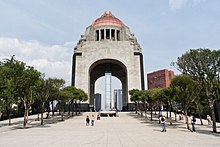
The chaos of the revolution deflected attention and resources away from the project, and only the foundations and the iron structure were completed. The building remained standing and rusting until the 1930s when it was finally decided to destroy the erected structure. However, the cupola was saved and turned into the Monumento a la Revolución (Monument of the Revolution) by Carlos Obregón Santacilia, and the massive structure stands today as a mausoleum to the heroes of the Mexican Revolution. [1]
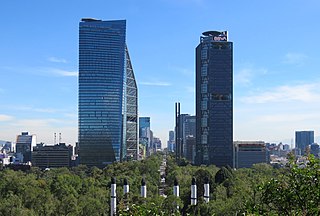
Paseo de la Reforma is a wide avenue that runs diagonally across the heart of Mexico City. It was designed at the behest of Emperor Maximilian by Ferdinand von Rosenzweig during the era of the Second Mexican Empire and modeled after the great boulevards of Europe, such as the Ringstraße in Vienna and the Champs-Élysées in Paris. The planned grand avenue was to link the National Palace with the imperial residence, Chapultepec Castle, which was then on the southwestern edge of town. The project was originally named Paseo de la Emperatriz in honor of Maximilian's consort Empress Carlota. After the fall of the Empire and Maximilian's subsequent execution, the Restored Republic renamed the Paseo in honor of the La Reforma.

The Angel of Independence, most commonly known by the shortened name El Ángel and officially known as Monumento a la Independencia, is a victory column on a roundabout on the major thoroughfare of Paseo de la Reforma in downtown Mexico City.

The Museum of the Revolution is located in the Old Havana section of Havana, Cuba, in what was the Presidential Palace of all Cuban presidents from Mario García Menocal to Fulgencio Batista. The building became the Museum of the Revolution during the years following the Cuban Revolution. The palace building was attacked by the Directorio Revolucionario 13 de Marzo in 1957.
São Bento Palace in Lisbon is the seat of the Assembly of the Portuguese Republic, the parliament of Portugal. Originally constructed in 1598, São Bento has served as the seat of Portugal's parliament since 1834, when the former monastery of the Benedictine Order was dissolved after the Liberal Wars. During the Portuguese constitutional monarchy, the palace served as the seat of the Cortes Gerais, the traditional parliaments of Portugal, until 1910.
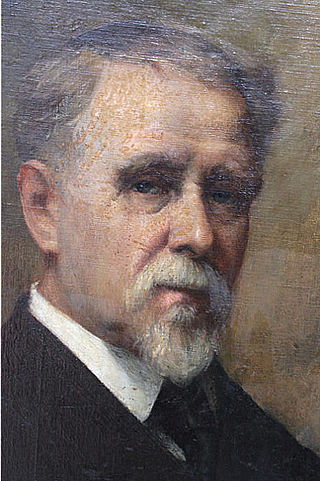
Henri Jean Émile Bénard was a French architect and painter.

The Legislative Palace of Uruguay is a monumental building, meeting place of the General Assembly of Uruguay, and the seat of the legislative branch of the Uruguayan government. It is located in the barrio of Aguada in the city of Montevideo.

The Stock Exchange Palace is a historical building in Porto, Portugal. The palace was built in the 19th century by the city's Commercial Association in Neoclassical style. It is located in the Infante D. Henrique Square in the historical centre of Porto, designated World Heritage Site by UNESCO.
The Mexico City administrative buildings are two buildings on the south side of the Zócalo in Mexico City divided by the avenue Avenida 20 de Noviembre. They house offices of the governing authority of Mexico City. The building to the west of 20 de Noviembre is the older one and has been the site of city administration since the Conquest. The one to the east is newer, built in the 20th century.
There are many landmarks in Buenos Aires, Argentina some of which are of considerable historical or artistic interest.

The Monument to the Revolution is a memorial arch commemorating the Mexican Revolution. It is located in the Plaza de la República, near the heart of the major thoroughfares Paseo de la Reforma and Avenida de los Insurgentes in downtown Mexico City. The monument is considered the tallest memorial arch in the world, standing 67 metres (220 ft) in height.

Carlos Obregón Santacilia (1896–1961) was a Mexican art déco architect. He trained at the Academy of San Carlos during the Mexican Revolution. He claimed a distinguished Mexican heritage, as great grandson of Benito Juárez and grand nephew of Alvaro Obregón.

The Museo Nacional de las Culturas is a national museum in Mexico City dedicated to education about the world's cultures, both past and present. It is housed in a colonial-era building that used to be the mint for making coins. Prior to this, the site was the home of the location of the Moctezuma's Black House. The mint was moved to Apartado Street in 1850, and the building was used for various purposes until it was converted to its current use in 1966.
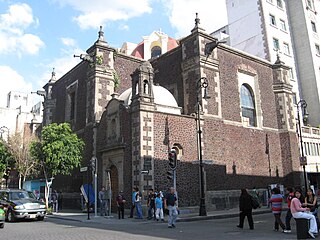
The Library of the Congress of Mexico mostly contains the records of the country's legislative sessions since its Independence. It is located at 29 Tacuba Street, near the corner with Bolivar in the historic center of Mexico City. This structure was originally part of a Poor Clares convent founded in the 16th century, but was confiscated by the Reform Laws of the 19th century. Since then, this building has been used as government offices, barracks and even a canteen. It current use was established in 1962, when the Library of Congress was founded by the Mexican government. Since then, the archives it houses have outgrown the building and a number are housed at the Palacio Legislativo de San Lázaro as well.

Colonia Tabacalera is a colonia or neighborhood in the Cuauhtémoc borough of Mexico City, on the western border of the city's historic center. It was created in the late 19th century along with other nearby colonias such as Colonia San Rafael and Colonia Santa María la Ribera. From the early 1900s, it became a mixture of mansions and apartment buildings, with major constructions such as the now Monument to the Revolution and the El Moro skyscraper built in the first half of the century. By the 1950s, the area had a bohemian reputation with writers, artists, and exiles living there. These included Fidel Castro and Ernesto “Che” Guevara, who met each other and began planning the Cuban Revolution there. Today, the colonia is in decline with problems such as prostitution, crime, street vending and traffic. However, the area is still home to some of the many traditional Mexican cantinas that populated it in its heyday.
Palacio Legislativo, may refer to:
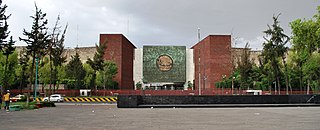
The Legislative Palace of San Lázaro is the main seat of the legislative power of the Mexican government, being the permanent meeting place of the Chamber of Deputies, as well as the seat of the whole Congress of the Union, when the Chamber of Deputies convenes in conjunction with the Senate of the Republic. Built in the late 20th century after a 1977 political reform, the complex is located in Mexico City about a mile east of the Zócalo central square, in the Venustiano Carranza borough or district, next to the Palace of Federal Justice. The complex draws its name from its location, as the San Lázaro Railway Station was the former occupant of the grounds where the palace was built.

The Palacio Federal Legislativo, also known as the Capitolio, is a historic building in Caracas, Venezuela which houses both the National Assembly and the National Constituent Assembly. Located southeast of the Plaza Bolívar, it was built between 1872 and 1877 by President Antonio Guzmán Blanco to a design by the architect Luciano Urdaneta Vargas. The Salón Elíptico, opened in 1877, is topped by a golden dome.

The Monument to Cuauhtémoc is an 1887 monument dedicated to the last Mexica ruler (tlatoani) of Tenochtitlan Cuauhtémoc, located at the intersection of Avenida de los Insurgentes and Paseo de la Reforma in Mexico City. It is the work of Francisco Jiménez and Miguel Noreña in the "neoindigenismo", and was proposed to promote the new government of Porfirio Díaz.

On 5 July 2017, colectivos and supporters of President Nicolás Maduro stormed the Palacio Federal Legislativo on the Independence Day of Venezuela, assaulting many members of the opposition-led National Assembly. At least 12 opposition legislators and their staff were injured as a result of the attack.

The Monumento a la Raza is a 50 meters (160 ft) high pyramid in northern Mexico City. It is located in the intersection of Avenida de los Insurgentes, Circuito Interior and Calzada Vallejo, in the Cuauhtémoc borough.